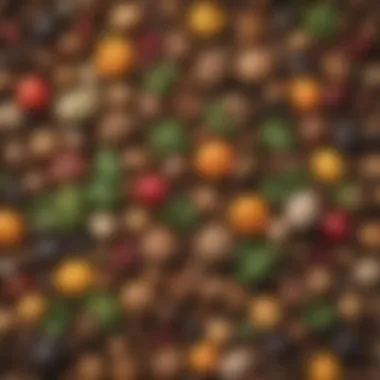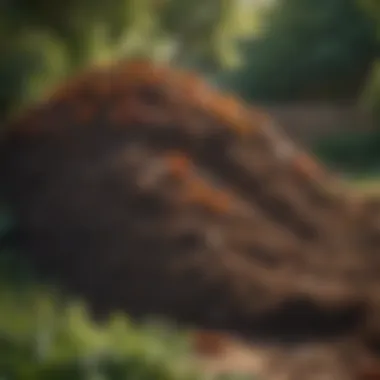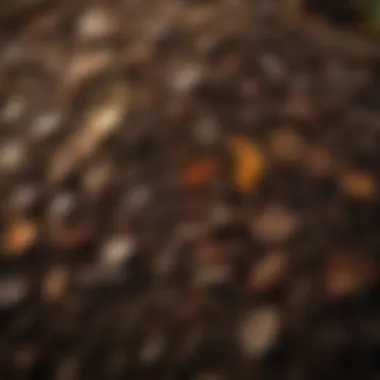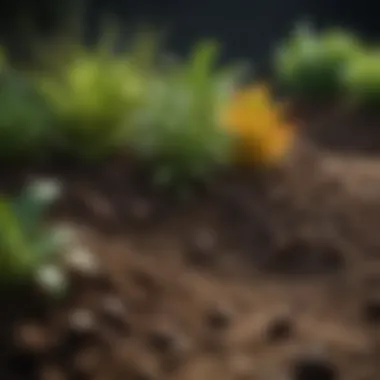Backyard Composting: A Complete Material Guide


Intro
Backyard composting is an effective method for managing organic waste. It transforms materials that would otherwise end up in a landfill into nutrient-rich compost. This compost can enhance soil health, support plant growth, and reduce the need for chemical fertilizers. Understanding what materials are suitable for composting is crucial for anyone looking to start this environmentally friendly practice.
Composting is not only beneficial for personal gardens but also plays a role in sustainable agriculture. It promotes a closed-loop system where waste is reused, thus minimizing environmental impact. This guide will help both casual gardeners and those with agricultural expertise understand the essentials of composting and the various materials that can be added to a composter.
Key Concepts and Terminology
Basic Definitions
Composting is the process of breaking down organic matter into a rich soil amendment known as compost. This process is facilitated by microorganisms, which decompose the material over time. The key components of composting include:
- Green materials: These are nitrogen-rich components, including kitchen scraps and fresh grass clippings.
- Brown materials: These are carbon-rich items, such as dried leaves, straw, and cardboard.
- Composting bin: A designated space or container for collecting organic waste.
Historical Context
The practice of composting has roots in ancient agriculture. Early farmers recognized the value of decomposed organic material for soil enrichment. Over centuries, composting evolved, and methods became more sophisticated. Today, backyard composting has gained popularity as people seek to reduce waste and create sustainable gardening practices.
Recent Innovations and Trends
Technological Advancements
In recent years, several innovations have emerged in the composting field. For instance, compost tumblers have simplified the process, allowing for better aeration and faster breakdown of materials. Additionally, smart composters equipped with sensors can monitor conditions within the bin, providing guidance on moisture and temperature.
Sustainable Practices
As awareness of environmental issues grows, sustainable composting practices have become prominent. Many gardeners are integrating composting with other sustainable techniques such as vermicomposting and bokashi. These practices not only produce compost but also promote biodiversity and improve soil structure.
Practical Applications and Techniques
Step-by-step Guides
To effectively compost at home, follow these simple steps:
- Select a Composting Bin: Choose a suitable container or designate a spot in your backyard.
- Layering: Add alternating layers of green and brown materials. This helps achieve a balanced carbon-to-nitrogen ratio.
- Aeration: Turn the pile regularly to aerate it and accelerate decomposition.
- Monitor Moisture: Keep the compost damp but not soaked, similar to a wrung-out sponge.
- Harvest: After several weeks to months, the compost should be ready to use when it resembles dark, crumbly soil.
Case Studies
Consider community gardens that have adopted composting programs. One initiative in a local urban garden showed a 30% reduction in waste sent to landfills while producing rich compost. Participants reported increased yields in their vegetable plots, demonstrating the effectiveness of composting practices.
"Composting not only reduces waste but revitalizes our soil, creating a more productive garden."
— Local Gardener
By understanding the key concepts and practices of composting, individuals can make informed decisions about what materials to include in their composters. This knowledge will foster healthier gardens and contribute to a sustainable environment.
Understanding Composting
Composting has emerged as an essential practice for many gardeners and farmers. It transforms waste materials into nutrient-rich soil. The process not only benefits your garden but also promotes sustainable waste management. Understanding the principles of composting can significantly impact both the health of your plants and the environment.
What is Composting?
At its core, composting is the natural process of recycling organic matter, such as food scraps and yard waste, into a fertilizer that can enrich soil. The decomposition occurs through the action of microorganisms and insects over a specific period. This process is primarily anaerobic, meaning it can happen without oxygen, although aerobic composting, which involves plenty of air, is common in backyard settings. The decomposition can result in a very useful product known as compost, which can help improve soil structure, retain moisture, and provide essential nutrients.
A successful compost heap balances green material and brown material. As the microorganisms break down the organic matter, heat is generated, facilitating the process. Often, people are surprised by how little space composting needs. Even small urban gardens can benefit from composting, making it accessible to almost anyone.
The Benefits of Composting
Composting offers numerous benefits, making it a valuable practice for individuals and communities. Here are some of the key advantages:
- Nutrient-Rich Soil: Compost improves soil health by providing vital nutrients that enhance plant growth.
- Waste Reduction: Composting reduces the amount of waste sent to landfills, promoting a more sustainable approach to waste management.
- Water Conservation: Compost improves soil structure, which can increase its ability to retain moisture. This means less frequent watering.
- Soil Erosion Prevention: Healthy soil holds together better and prevents erosion, protecting the topsoil and promoting plant health.
- Reduced Carbon Footprint: Composting lowers greenhouse gas emissions by diverting organic waste away from landfills to be utilized instead.


"Composting is an effective method to improve your garden’s performance while contributing positively to the environment."
Materials for Backyard Composting
Understanding the right materials for backyard composting is vital in achieving a successful compost pile. The materials you choose directly affect the speed of decomposition and the quality of the finished compost. Different components serve unique roles, and the mix of green and brown materials is essential for balance. This section breaks down the various categories of compostable materials, focusing on their benefits and how to use them effectively.
Green Materials
Green materials are high in nitrogen, promoting microbial activity that speeds up decomposition. Their incorporation is essential for the health of your compost. Here are the key components of green materials:
Grass clippings
Grass clippings are a popular choice among gardeners. They decompose quickly and are rich in nitrogen. Their high moisture content makes them effective at maintaining the necessary damp environment for composting. However, an overabundance of grass clippings can lead to compacting, restricting airflow.
Fruit and vegetable scraps
These scraps are a great source of nitrogen. They contribute nutrients that enhance the compost's quality. Their moisture content also helps keep the pile damp. However, they can attract pests if not buried well within the pile. Using predominantly uncooked scraps minimizes this risk.
Coffee grounds
Coffee grounds are often overlooked as composting elements. They are rich in nitrogen and can help boost soil fertility. A unique feature of coffee grounds is their acidity, which can benefit certain plants. However, too much may lead to a lopsided pH balance in the compost.
Plant trimmings
Trimmings from various plants provide a diverse range of nutrients. They often contain cellulose, promoting a broader spectrum of microbial activity. However, some hardy trimmings may take longer to decompose if not shredded.
Brown Materials
Brown materials are high in carbon and provide the energy needed for microorganisms. This section covers several common brown materials:
Dried leaves
Dried leaves are a fantastic source of carbon and add substance to the compost mix. They break down slowly but continue to enrich the compost as they do. Shredding leaves can accelerate decomposition. Their diversity in composition also adds to a well-rounded compost.
Twigs and branches
Small twigs and branches provide structure to the compost. They create air pockets that allow for better aeration. While they decompose slowly, their presence can enhance drainage in the pile. Care should be taken to chop them into smaller pieces to hasten decomposition.
Cardboard
Cardboard is an excellent carbon-rich material that can create a good structure in the compost. It needs to be non-waxed and free from toxic inks or coatings. Shredding cardboard facilitates faster breakdown. It can retain moisture but should not dominate the mix.
Paper products
Paper products, such as newspaper and office paper, are good sources of carbon as well. They need to be added in moderation, as excessive amounts can mat together, creating a barrier. Choosing uncolored and non-glossy paper is preferable.
Nitrogen-Rich Additives
Nitrogen-rich additives are essential for bolstering the microbial community. The following materials are useful in this category:
Manure from herbivores
Herbivore manure, such as from cows or horses, is highly beneficial. It contains valuable nutrients and microorganisms that enhance the composting process. Care should be taken to use well-composted manure to reduce pathogens and odors.
Alfalfa meal
Alfalfa meal is yet another excellent nitrogen source. It promotes rapid decomposition and soil health. This additive is often used in smaller quantities as part of a balanced mix.
Food scraps with high protein content


Include food scraps high in protein, such as meat alternatives. They provide quick bursts of nitrogen. However, moderation is key due to potential odor issues and pest attraction.
Common Kitchen Waste
Kitchen waste comprises a variety of materials that contribute to a healthy compost mix. Here’s a closer look:
Eggshells
Eggshells are rich in calcium, promoting healthy plant growth. Their brittle nature means they break down slowly, so they should be crushed before adding. They should not be the sole source of nutrients but complement other materials well.
Leftover grains
Leftover grains can enrich your compost due to their nitrogen content. However, they can attract pests if not managed well. They should be adequately mixed with other materials.
Vegetable peels
Vegetable peels are an excellent source of nutrients and moisture. They break down easily, but introducing too many can lead to odor issues. Variety is crucial to avoid this problem.
Yard Waste
Yard waste serves as an abundant resource, rich in carbon and nitrogen content. Below are key contributors:
Small branches
Though often considered brown material, small branches offer structural support in the compost. When chopped or shredded, they break down adequately and allow air circulation.
Leaves
Leaves add nutrient density to the compost. Their diversity contributes to a balanced nutrient profile. They should ideally be mixed with other materials to prevent compacting.
Shredded hedge trimmings
Hedge trimmings can vary widely in composition. Shredding them enhances their breakdown. They should complement other yard waste to form a nutritious blend in the compost.
Materials to Avoid in Composting
Composting effectively is a balance of incorporating various organic materials. However, not all materials are suitable for composting. Understanding what to avoid is essential for producing high-quality compost, protecting soil health, and maintaining an effective compost system. Certain items not only can hinder the composting process but may also introduce harmful pathogens or pests into your garden. Below are the main categories of materials to avoid when composting.
Meat and Dairy Products
Meat and dairy products, such as leftover chicken, cheese, and yogurt, should be excluded from your compost pile. These materials can decompose slowly and create foul odors during the process. Moreover, they attract pests, including rodents and scavengers, which can damage not just your compost but also nearby plants. Additionally, the risk of pathogens exists, as meat and dairy may carry bacteria that can survive the composting process.
Recall that effective composting relies on achieving sufficient temperatures to kill pathogens. Given that meat and dairy do not break down well without these temperatures, protecting your compost from potential health risks is a wise choice.
Oils and Fats
Similar to meat and dairy, oils and fats can complicate the composting process. Products like cooking oils, greasy leftovers, and butter can create a waxy mixture that inhibits airflow in your compost pile. This lack of aeration can lead to anaerobic decomposition, producing unpleasant smells and possibly harming beneficial microorganisms.
Moreover, excess oil can coat other materials in the compost, making them harder to break down and disrupting the delicate balance of carbon and nitrogen essential for healthy compost production.
Diseased Plants
Introducing diseased plants into your compost bin poses risks that cannot be overlooked. Although it may seem like a good way to recycle green waste, pathogens present in infected plants can survive the composting process. Consequently, these pathogens can remain dormant and later reinfect your garden or newly planted crops.
As such, it is advisable to dispose of diseased plants through municipal waste systems or by burning, depending on local regulations. This prevents possible contamination and ensures a healthier gardening environment.
Weeds with Seeds
While composting weeds may seem beneficial because they contribute organic matter, weeds that have gone to seed should be avoided. If seeds are added to the compost and they do not die during the composting process, they can germinate when you apply the finished compost to your garden. This could lead to an increase in unwanted weeds, further complicating an already tedious weed control effort.


The best practice is to either compost weed plant materials that have not yet seeded or to use other methods to handle the weeds before they can disperse their seeds.
Pet Waste
Pet waste, particularly from cats and dogs, poses considerable challenges in composting. This waste can contain harmful pathogens and parasites that can survive even the highest temperatures achievable in backyard compost piles. Using pet waste in compost can introduce health risks, potentially contaminating plants and soil that are intended for human consumption.
It is generally safer to dispose of pet waste through specialized composting systems designed specifically for this purpose, or through standard waste disposal methods to maintain a sanitized and healthy environment for your garden.
Establishing Your Compost Bin
Establishing your compost bin is a crucial aspect of effective backyard composting. The choice of bin and its setup impacts the efficiency of the composting process. A well-placed and correctly chosen compost bin can enhance the decomposition of organic materials. It promotes healthy microbial growth, resulting in rich, nutrient-dense compost. Additionally, considering factors like location and types of bins can save time and effort in maintaining your compost health.
Choosing a Location
The location of your compost bin plays a significant role in ensuring successful composting. Ideally, it should be accessible yet unobtrusive in your yard. Select a spot that gets partial sunlight; this warmth can aid in the breakdown of materials. Avoid areas where water tends to accumulate, as excess moisture can lead to anaerobic conditions, hindering composting. Furthermore, placing the bin close to your kitchen makes it convenient to add scraps and reduces the effort needed to maintain the bin.
Types of Compost Bins
Choosing the right type of compost bin can also vastly improve your composting experience. Here are a few common types:
Enclosed bins
Enclosed bins are compact and often made of materials like plastic or wood. They provide an excellent environment for composting by containing heat and moisture. The key characteristic of enclosed bins is their ability to reduce odors and deter pests, making them a popular choice among urban gardeners. This is beneficial, especially if space is limited or you need to manage the aesthetics of your yard. However, one drawback is that enclosed bins require regular turning to ensure air circulation.
Open piles
Open piles consist of layers of organic materials stacked together. These are easy to build and maintain, making them a favored option for many gardeners. One key characteristic of open piles is their simplicity, requiring no additional materials. They promote good airflow, which helps to speed up decomposition. Despite being cost-effective, they may attract pests and produce odors if not properly managed. Additionally, open piles require sufficient space as they can expand when layers are added.
Vermicomposting systems
Vermicomposting systems utilize worms to break down organic materials. These systems are notably efficient and can produce compost quickly. A unique feature of vermicomposting is its ability to be set up in smaller spaces, like apartments. This makes it an attractive choice for urban gardeners or anyone with limited space. However, they do require specific conditions of moisture and temperature to keep worms healthy, which can be a drawback for some.
Maintaining Your Compost
Maintaining your compost is crucial for several reasons. First, it ensures that the composting process runs efficiently, producing quality compost that enhances soil health. Regular maintenance helps to accelerate decomposition and minimizes unpleasant odors that can arise from an improperly managed pile. Moreover, understanding how to maintain your compost can help avoid common pitfalls, such as insufficient aeration or incorrect moisture levels, both of which can hinder the composting process.
Turning the Pile
Turning the pile is an essential practice that introduces oxygen into your compost. Oxygen is vital for aerobic bacteria, which are the primary microorganisms responsible for breaking down organic matter. A well-aerated compost pile decomposes faster and more efficiently. When you turn the pile, use a pitchfork or compost turner, ensuring that material from the center is moved to the outside and vice-versa. This aids in balancing the materials, leading to uniform decomposition. It's generally recommended to turn your compost every few weeks, depending on the size and composition of the pile. Regular turning not only speeds up the process but also prevents the pile from compacting, which can stunt air circulation.
Monitoring Moisture Levels
Moisture is a key factor in the composting process. Too little moisture will slow down or halt decomposition, while too much can create anaerobic conditions, leading to foul smells and pests. The ideal moisture level is comparable to that of a wrung-out sponge. To check moisture, you can grab a handful of the compost; if it crumbles easily, it may need water. If it drips water, it's too wet.
You can maintain proper moisture levels by spraying with water selectively if it becomes dry or adding more dry materials like shredded leaves or cardboard if it gets too wet. Regular checks will help ensure your compost maintains the right balance, thus promoting effective decomposition.
Temperature Management
Temperature is an indicator of microbial activity within your compost pile. The pile should reach a temperature between 130°F to 160°F (54°C to 71°C) for effective composting. This heat is produced by the breakdown of organic materials. To help manage temperature, turning the pile is again important. Turning introduces oxygen and redistributes materials, which can help maintain high temperatures.
Using a compost thermometer can help monitor the temperature accurately. If the temperature starts to drop below 130°F (54°C), you may need to turn the pile or add nitrogen-rich materials like grass clippings or food scraps to revive activity. Maintaining an optimal temperature not only ensures efficiency but also reduces the chances of weed seeds or pathogens surviving in the final compost.
Properly maintaining your compost is a balance of turning, moisture control, and temperature management. With careful attention, you can achieve nutrient-rich compost that benefits your garden.
By focusing on these three areas, you'll create a thriving compost pile that transforms organic waste into valuable soil amendment. Each step taken in maintenance contributes significantly to the quality and efficiency of your backyard composting efforts.
Ending
Understanding the role of composting in sustainable agriculture is critical. This article elaborates on what materials can or cannot be included in a backyard composter. Composting helps recycle organic waste, reducing landfill contributions significantly. While the process may seem complex, the key points outlined serve as a guide to simplify composting practices for everyone.
Summarizing Key Points
- Materials Suitable for Composting: It is essential to differentiate between green and brown materials to maintain balance. Green items, like grass clippings and vegetable scraps, add nitrogen. Brown items, such as dried leaves and cardboard, contribute carbon.
- Items to Avoid: Certain materials should never enter the composter. These include meat, dairy, and oils, which can attract pests and create odors. Diseased plants and pet waste also pose health risks.
- Compost Maintenance: Regularly turning the compost pile, monitoring moisture levels, and managing temperature are vital. These actions promote decomposition, creating rich, fertile compost that benefits soil health.
This summation encapsulates the essence of successful backyard composting. Familiarity with these aspects can greatly enhance gardening efforts.
Encouragement for Sustainable Practices
Embracing composting as a sustainable practice fosters environmentally conscious behavior. As individuals begin to implement composting, they contribute to reducing waste and enhancing soil health. Consider this a small yet impactful step toward a greener future.
- Start Small: If you're new to composting, begin with kitchen scraps or yard waste. Gradually expand as you gain confidence.
- Educate Others: Share knowledge about composting benefits within your community. Encourage neighbors to participate in sustainable practices, creating collective environmental awareness.
- Utilize Resources: Online platforms such as Reddit or Facebook offer communities where you can ask questions and share experiences related to composting. Tap into these networks for tips and support.















